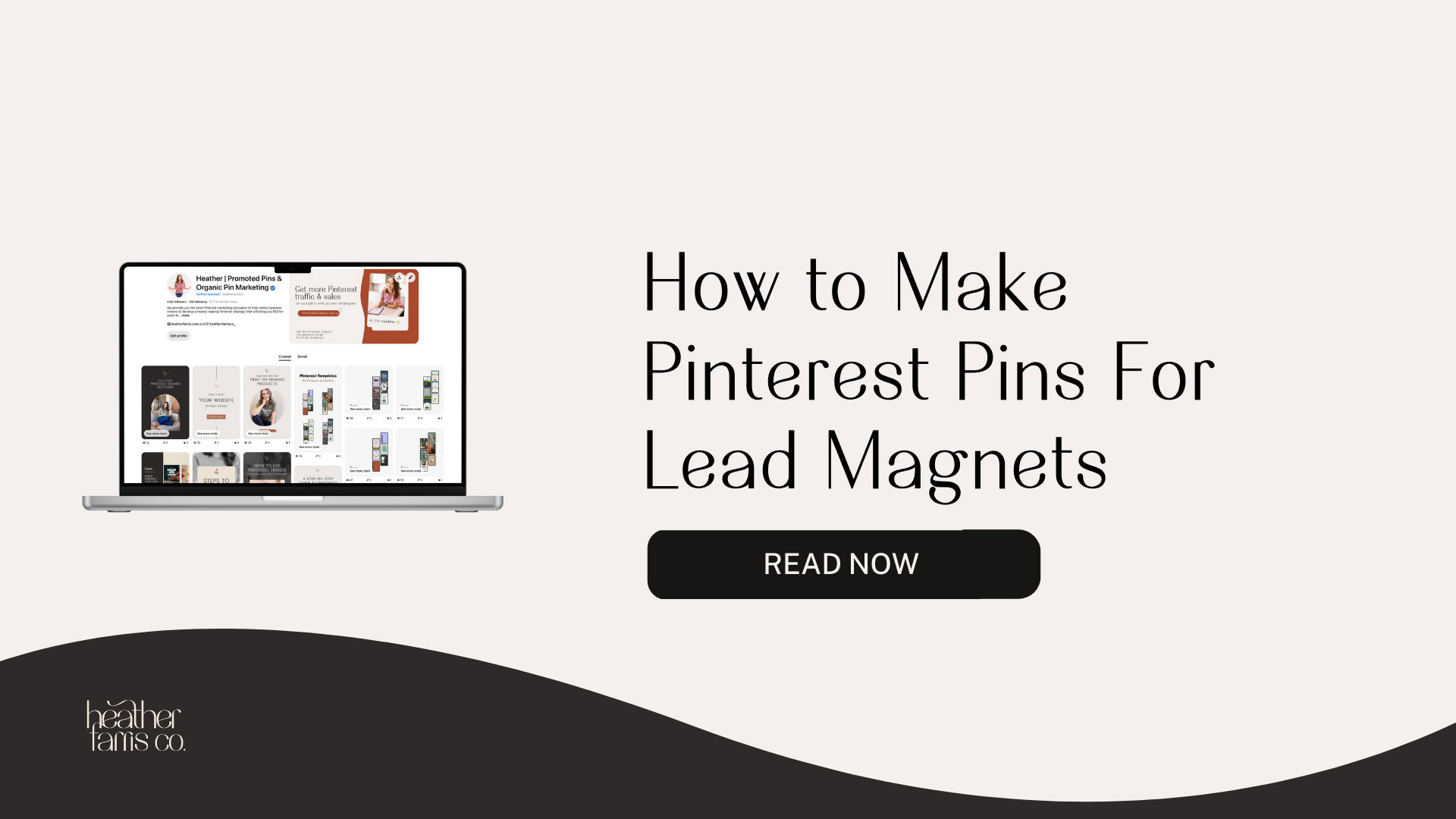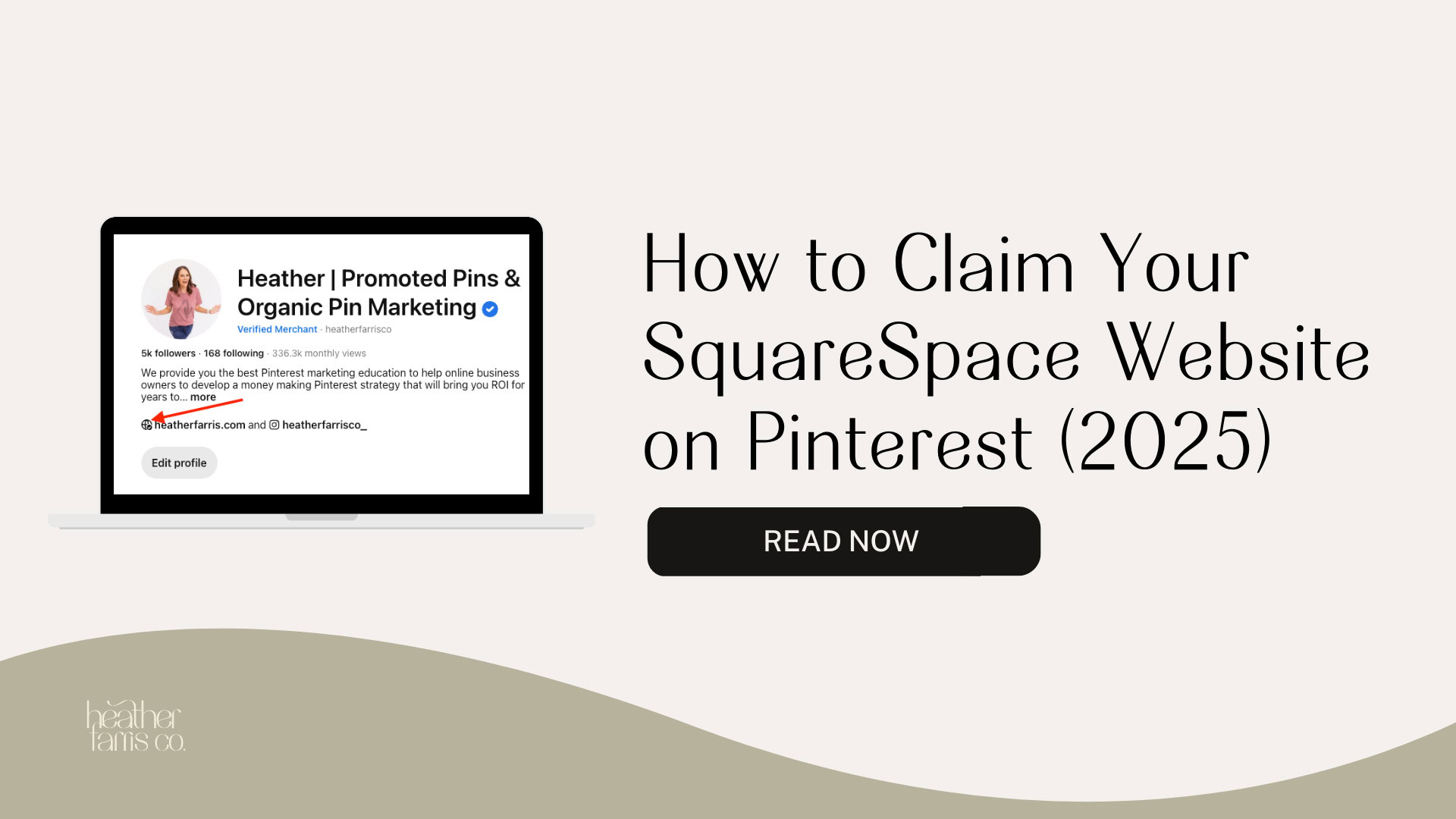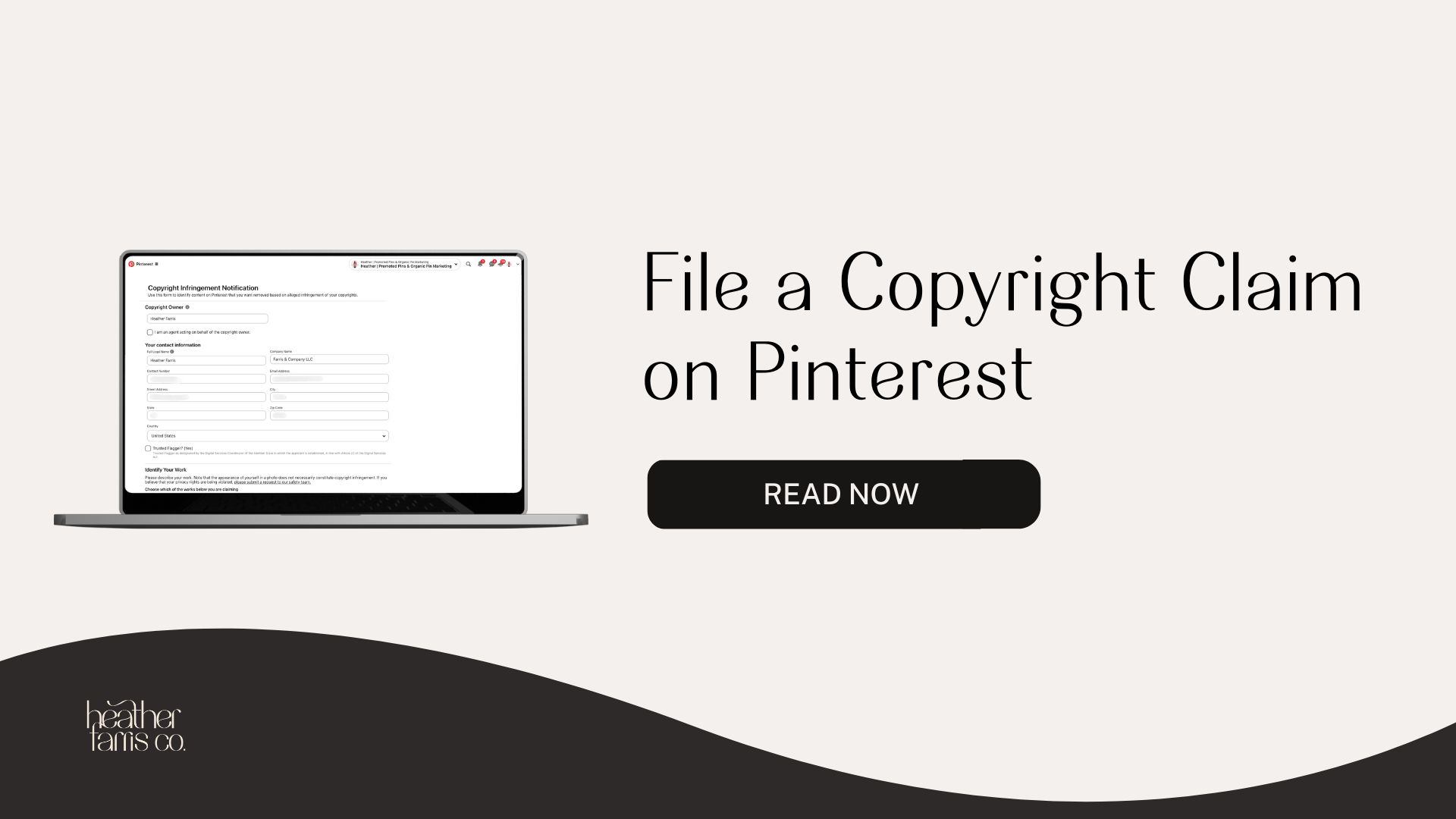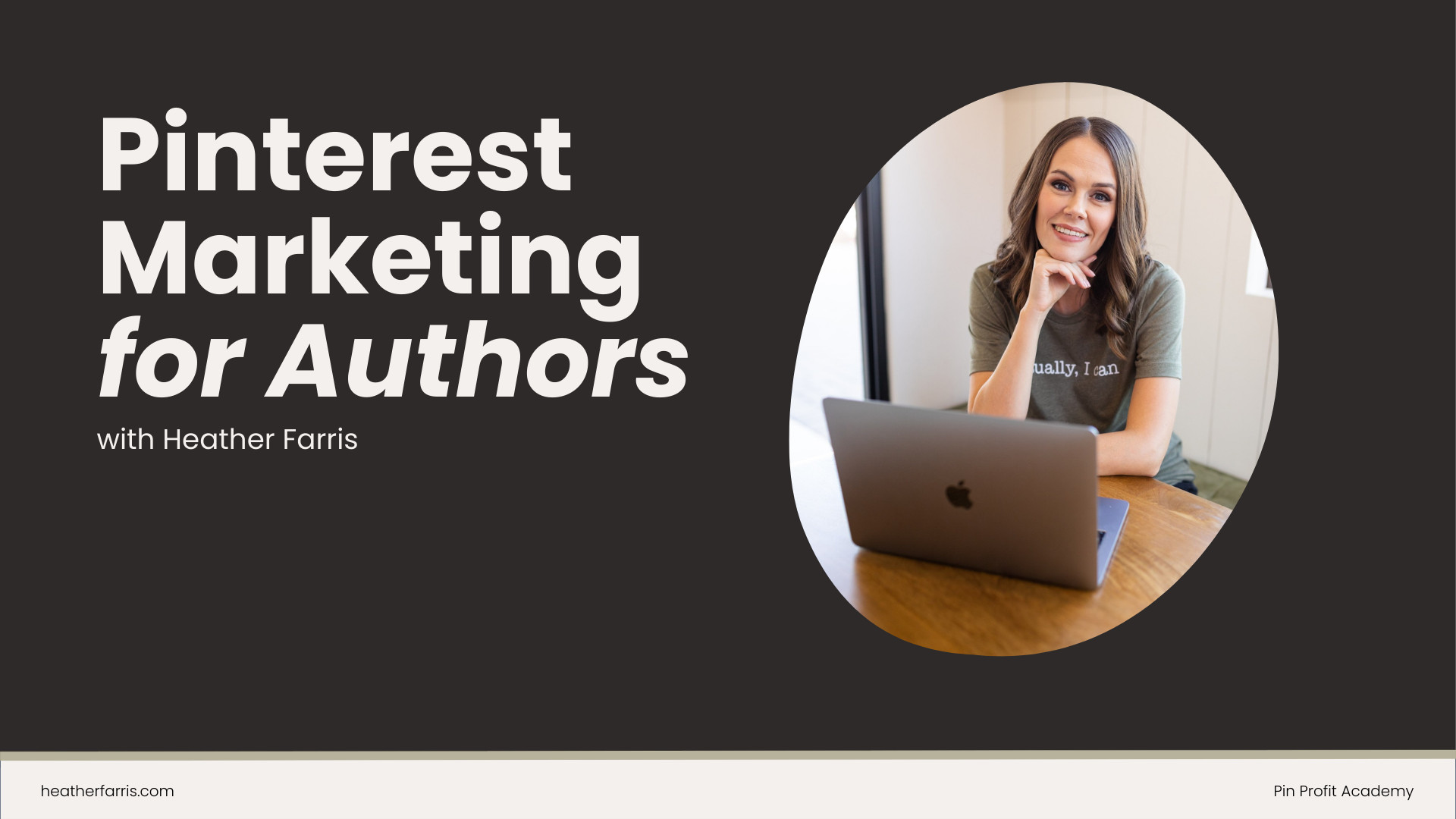Heather is a seasoned
Pinterest marketing expert & educator using the platform since you could reach the bottom of the feed - 2010.
About Heather Farris >
Pinterest Search Ads: How to Test a Pinterest Advertising Strategy w/o Spending a Fortune
June 26, 2021
How to test Pinterest Advertising Strategy without spending a fortune?
What are Pinterest search ads & can you use them to get lower cost leads? I am going to show you the results I got after running 30 days of search only ads on Pinterest at a mere $5 per day.
I recently got a question from a subscriber (Laura) which prompted this post. She asked,
“Can you do a video on how to use ads when you don’t have a huge budget to spend? I just want to test them, but I don’t know where to start.”
If you are interested in advertising on Pinterest and you want to do it more affordably, read on.
I am going to walk you through a low-budget ad strategy that I used and show you how you can use it too.
I have been raving about Pinterest search ads since the algorithm shift when Pinterest changed traffic ads to a consideration budget optimization method that was implemented in February 2021.
Once that algorithm shift happened within the traffic campaigns and started to settle, I noticed a really big uptick in ROAS and overall performance on my clients’ campaigns where we were running keyword only campaigns. This change was visible not only with conversions but also with consideration campaigns.
So I started testing this theory across my campaigns where you are just targeting keywords with a search only placement.
Within your Pinterest ads, you have a consideration and conversion campaign objective where most people will run ads.
If you are a beginner and you are just getting started, and want to test it out with a small budget, this is a perfect place to start. I’m going to walk you through this whole process later in this post.
What are Pinterest Search Ads?
They are a consideration campaign with a search-only placement, and you are targeting only keywords. Before you turn any ad campaigns on you want to ask yourself what is my objective for running ads?
Promoting Blog Posts
In most cases, if you are just testing out Pinterest ads, you may want to test out running traffic to a shop page. You may also want to test out running traffic to blog posts or digital product funnels.
In the case study for this example, I ran traffic to a freebie. Then I actually added a top of funnel ad group to it to see if it would get a few more conversions. It didn’t go as well. This ad group did garner quite a few clicks but it wasn’t converting to sales like the direct to tripwire funnel did.
Promoting Landing Pages or Sales Pages
You can test the data and see where your audience is on the platform. Or you could be looking for sign-ups or conversions in your shop or on your website.
Your objective is going to be very personal, and that is something you will set for yourself.
In this case study, my objective was to get sign-ups and sales to cover the ad spend, get people deeper into my funnel, and eventually get them to join my Pinterest membership.
What is a Consideration Campaign?
Consideration campaigns are pay-per-click campaigns, much like Google ads campaigns, where you only pay when someone clicks on your ad. The benefits of a consideration campaign are that you are billed per click. They can see your pin in their feed, but you are not getting billed if they do not click on it.
So you need to =to have a really strong call to action to get people to click all the way through to your ad.
Benefits of a Consideration Campaign
There are some pros to consideration campaigns:
Cheaper ad costs
They are historically cheaper because you only pay for those willing to click on your ad.
This algorithm is more mature
Not only are they cheaper, but it is an older algorithm. When they release Pinterest ads, they just release them in traffic. That was the very first iteration of ads on Pinterest.
Not only is the algorithm more mature, but you can also learn more about your audience or your potential audience while spending a lot less money.
You can learn more about your audience
One benefit to running a consideration campaign over a conversion campaign, especially in the beginning, is that you can get to know your audience. You can learn who your audience is, what they want, what they are willing to click on.
You can also install a heat map of sorts on your website to figure out if your pages are converting. Doing that in traffic and then flipping that using those metrics in a conversion campaign is something that I have found to be effective later on.
Familiarize yourself with the Pinterest ads dashboard
You can familiarize yourself with the dashboard, how the algorithm works, all the metrics. You don’t have to spend a ton of money and have to worry about hiring help initially or even trying to get a hold of somebody at Pinterest and possibly just to get bad advice.
Billed by the campaign
They are billed with the campaign level and not the ad group level anymore. That means you can put multiple ad groups in one campaign and test out your budget across all ad groups to figure out which one is the winning campaign.
I recently did this in a client account. She was getting a lot of conversions on her ad before the end of the year, and then her ads shut off. She wanted to restart.
We restarted with her budget on a consideration campaign with five ad groups. So the campaign actually spread that money over all the ad groups, and we were quickly able to figure out which ad group was the winning ad group and put all of that budget towards that one group.
Within that timeframe we saw a 2.25x ROAS on the winning ad group. Within 30 days of turning those ads on, we actually started to see that pickup.
What is a Conversion Campaign?
Let us quickly run through what a conversion campaign is and why they are so different. A conversion campaign is billed per one thousand impressions. If someone sees your ad but never actually clicks on it, you will still get billed. That is why conversion campaigns and optimizing with events isn’t where I suggest beginners to start. Especially if your pixel still isn’t warmed up.
Read More: Promoted Pins on Pinterest: How to Setup & Optimize Your Conversion Campaigns
What Should I Expect When I Launch a Promoted Pin Campaign?
Expectations are going to be different for every advertiser. And rightfully so. Everyone has a different product, a different audience, a different budget to spend, and different funnels. It is all so personalized to each individual.
Track your overall campaign metrics for your defined goals
One thing you need to do in the beginning is to set your expectations to figure out what your goals are for this campaign and what KPIs you need to track.
In my case, I wanted to track sign-ups and tripwire sales. So I needed to track two different events inside the campaign. You can still do this in consideration campaigns as long as your events are placed correctly on your site.
I made sure my sign-up event codes were placed, and then I also made sure my checkout event codes were placed in the correct locations.
So know what your objective is and what your KPIs need to be.
Know that it may take 7 to 10 days to see any forward momentum
The second expectation you can set for yourself is your campaign could take seven to ten days to do anything. In my case, for this campaign, it took two weeks for the results to actually be seen. It wasn’t until the second two weeks that I started to see the conversions and sign-ups happening regularly.
Even if your campaign doesn’t go well, you are collecting data
If your campaign doesn’t go well, that’s ok because you are collecting data.
- What kinds of keywords work?
- What imagery worked?
- What happened on the landing page when someone hit?
- Did you install hotdoor, and can you see where they left the page?
These are all the things that you want to know if you are launching a promoted pin campaign for the first time. That way, you know you are set up for conversion events. If you are not set up for conversion events, then you need to tweak things and make sure that you get that setup.
When I started this campaign in March, I was struggling with my event codes on leadpages, and I ended up migrating the entire funnel to Elementor mid promoted-pin campaign. I just built all the funnels on Elementor and then flipped the switch with the URLs, and it was flawless.
There was no interruption in anything that happened, and that’s when I noticed that in the second two weeks the conversion started flowing in. So I think my Elementor pages were built for better conversion overall and my event codes were firing correctly when I built them the second time.
How to Get Started with Pinterest Search Ads?
Research your keywords first
The very first thing you are going to do is start researching your keywords. This is important because this is a search-only campaign. I would suggest starting with 100 to 150 keywords. You can do more than that or even less. I would do a minimum of 25 at the very least.
Within the first few weeks, you are going to be archiving keywords to optimize the campaign.
Create your imagery and optimize your profile
Research and find all of your inspiration and imagery and get your ad imagery created. I did this very quickly inside of a Canva. I actually created them for the organic and ended up using them for the promoted pin campaign. Make sure that you are creating images and that they have a very strong cause to action on them, and they are related to the landing page. They need to be highly relevant.
Load your dashboard
Once you have your keywords and your imagery ready and you have all your event codes and your pixels installed correctly, you’re going to come into your dashboard, and you are going to create a really quick ad.
On the next page you are going to name the campaign and set your budget and choose run continuously.
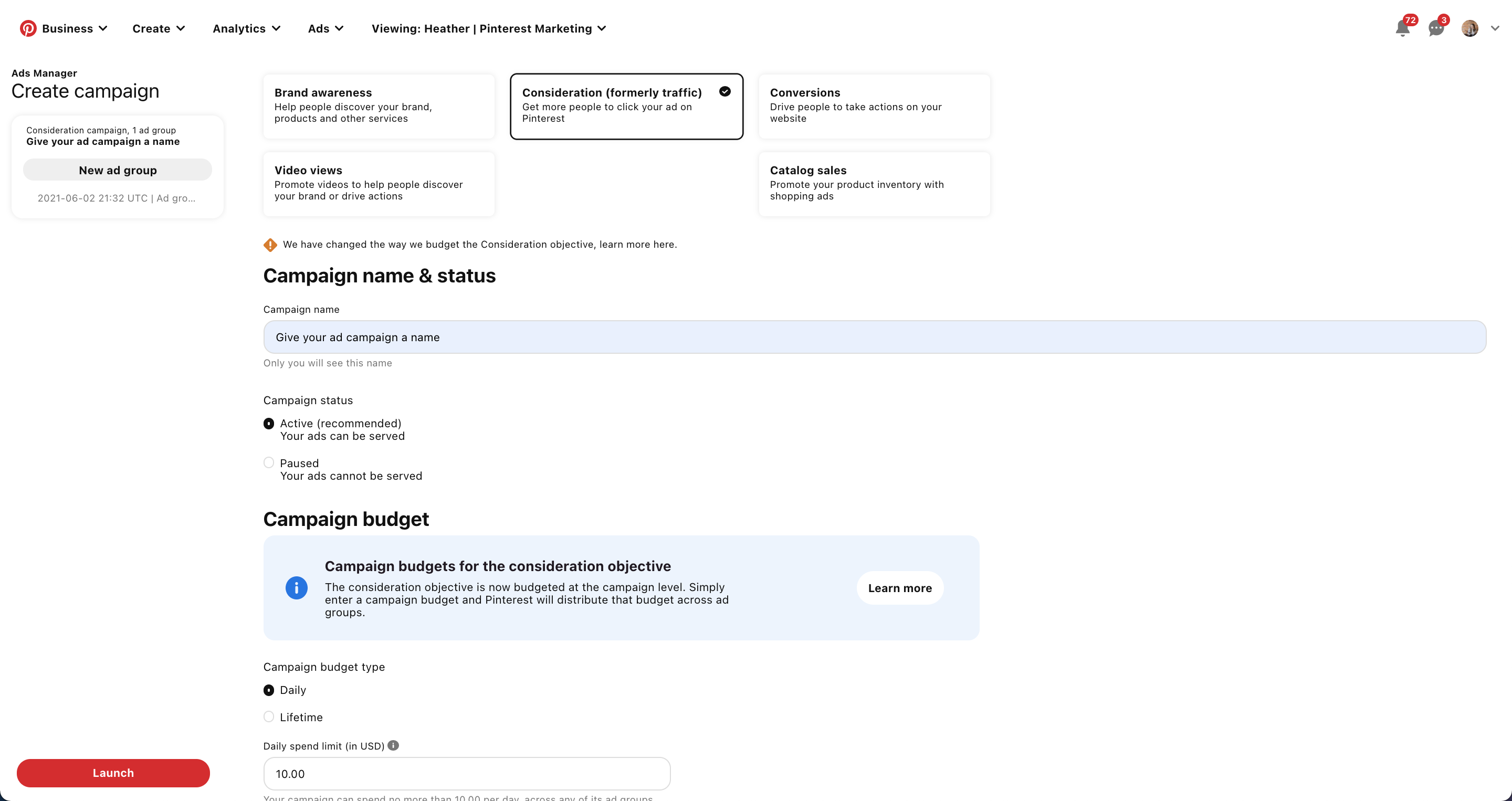
Name your ad group
You are going to name your ad group whatever your targeting is. Typically this is how I name my ad groups.
Click choose your own strategy
Under your targeting strategy, you are going to select your own. That’s going to open all these targeting options. You are going to skip past audience lists, and you are going to jump into keywords and interests.
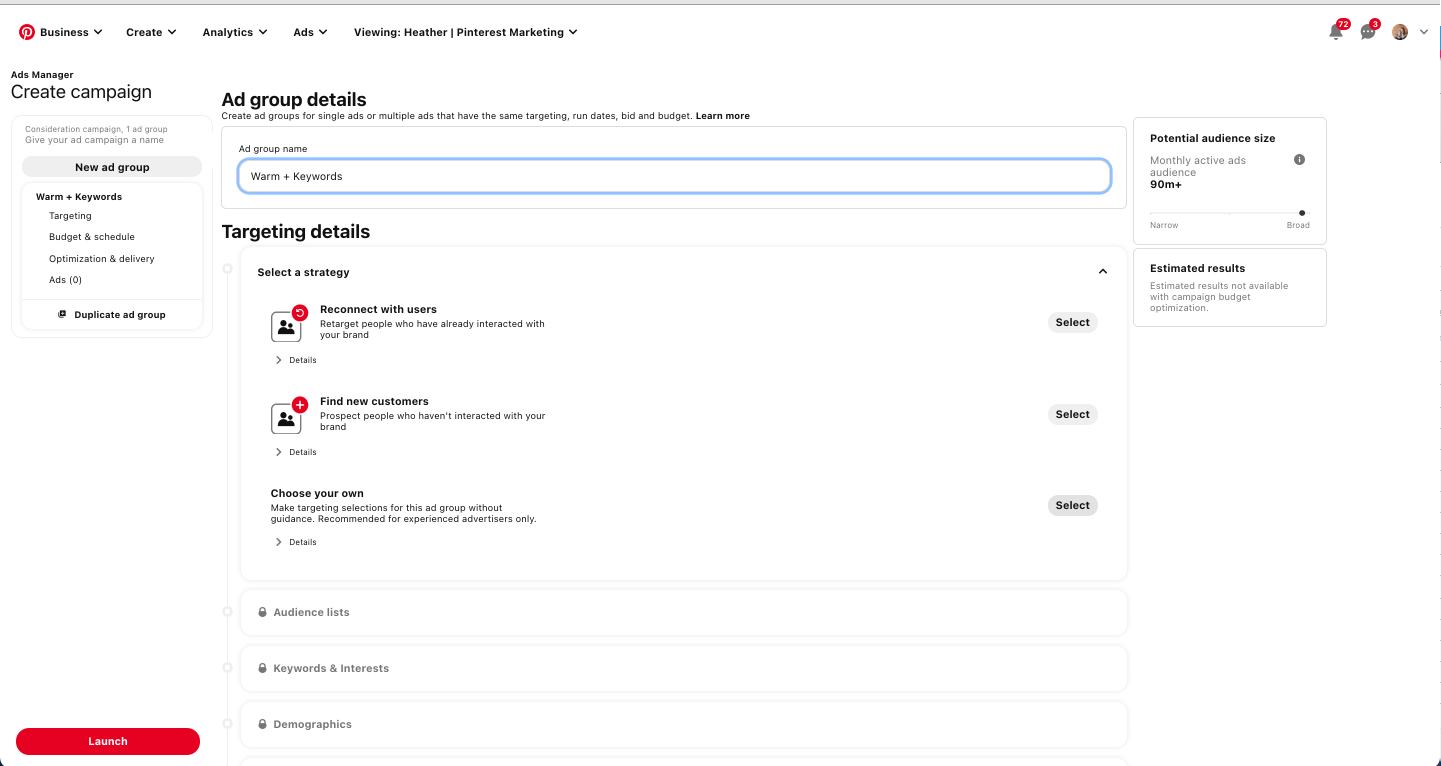
Input keywords
You then toggle over to keywords and input the keywords. I do keywords research, put them into a spreadsheet, and then I put them in. You can use the search bar to find keywords and add them to the campaign. Start broad and then add in phrases and exact words as optimizations later.
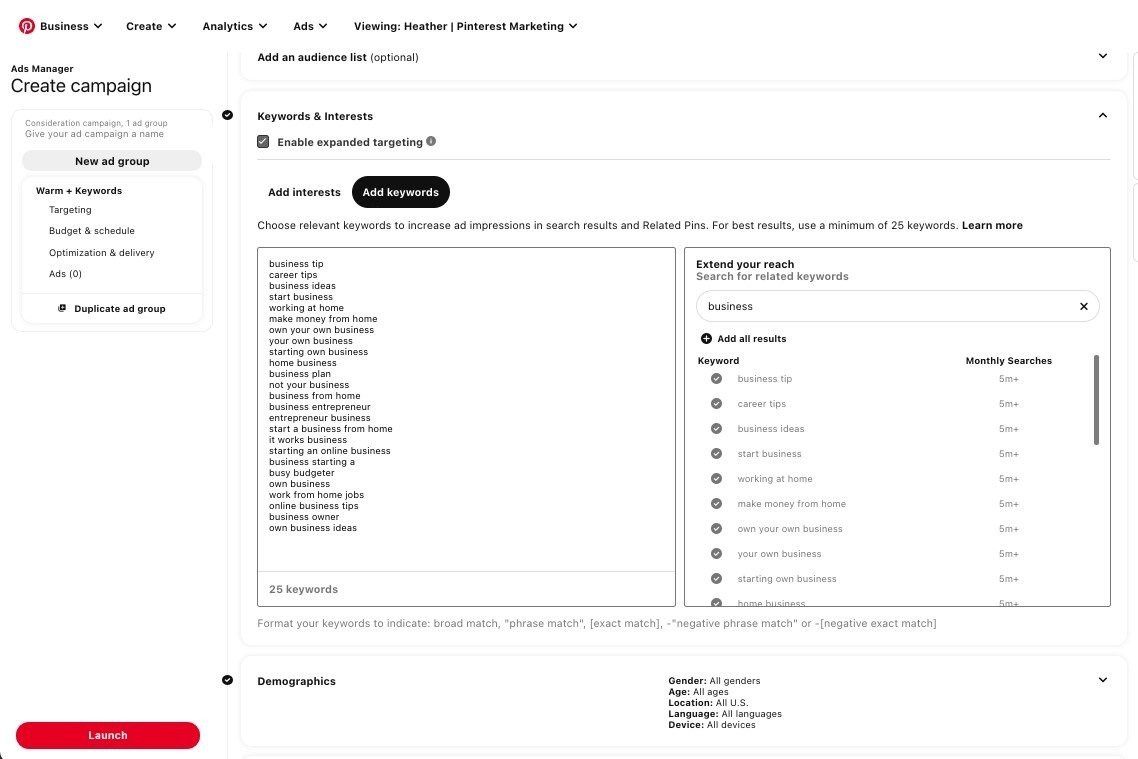
When you have selected your keywords, you are going to hop into demographics. I would suggest using all genders, all ages, locations, languages, and devices in the beginning because those are optimization tools later.
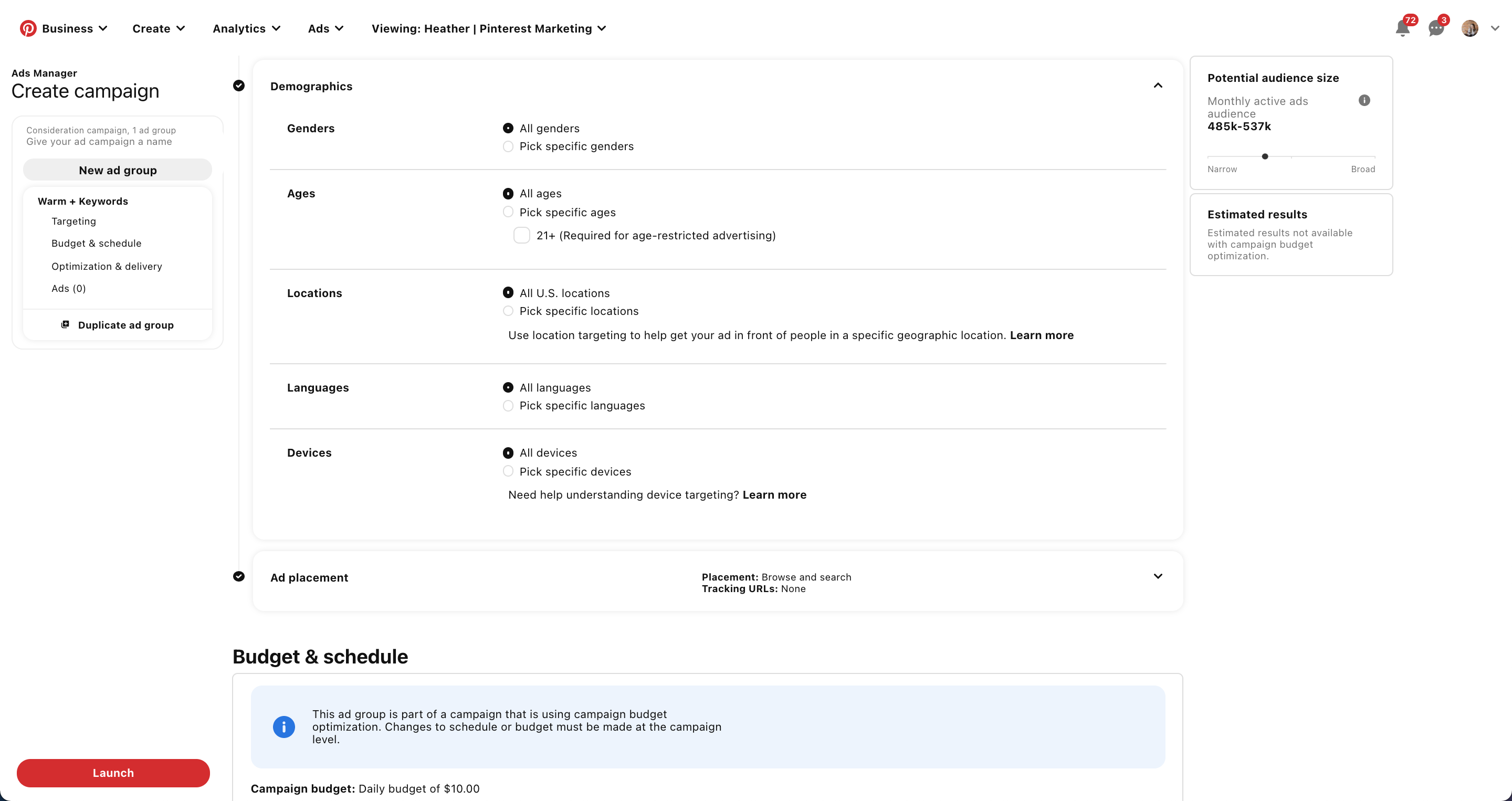
Go to ad placement and choose ‘search’
This is the most important part other than your keywords and imagery. Make sure this is selected for search. You want to make sure you are set up for ‘search only’ placement; otherwise you are also going to have browse delivery and that’s not the goal of this campaign. In this case, our strategy is to be in a search-only campaign.
Your budget is billed at the campaign level, so you don’t make any changes here. You are going to leave your optimization and delivery on automatic because automatic bidding is well seasoned here.

Choose your images
You are then going to choose your images. Review your chosen images to ensure the URL is correct.
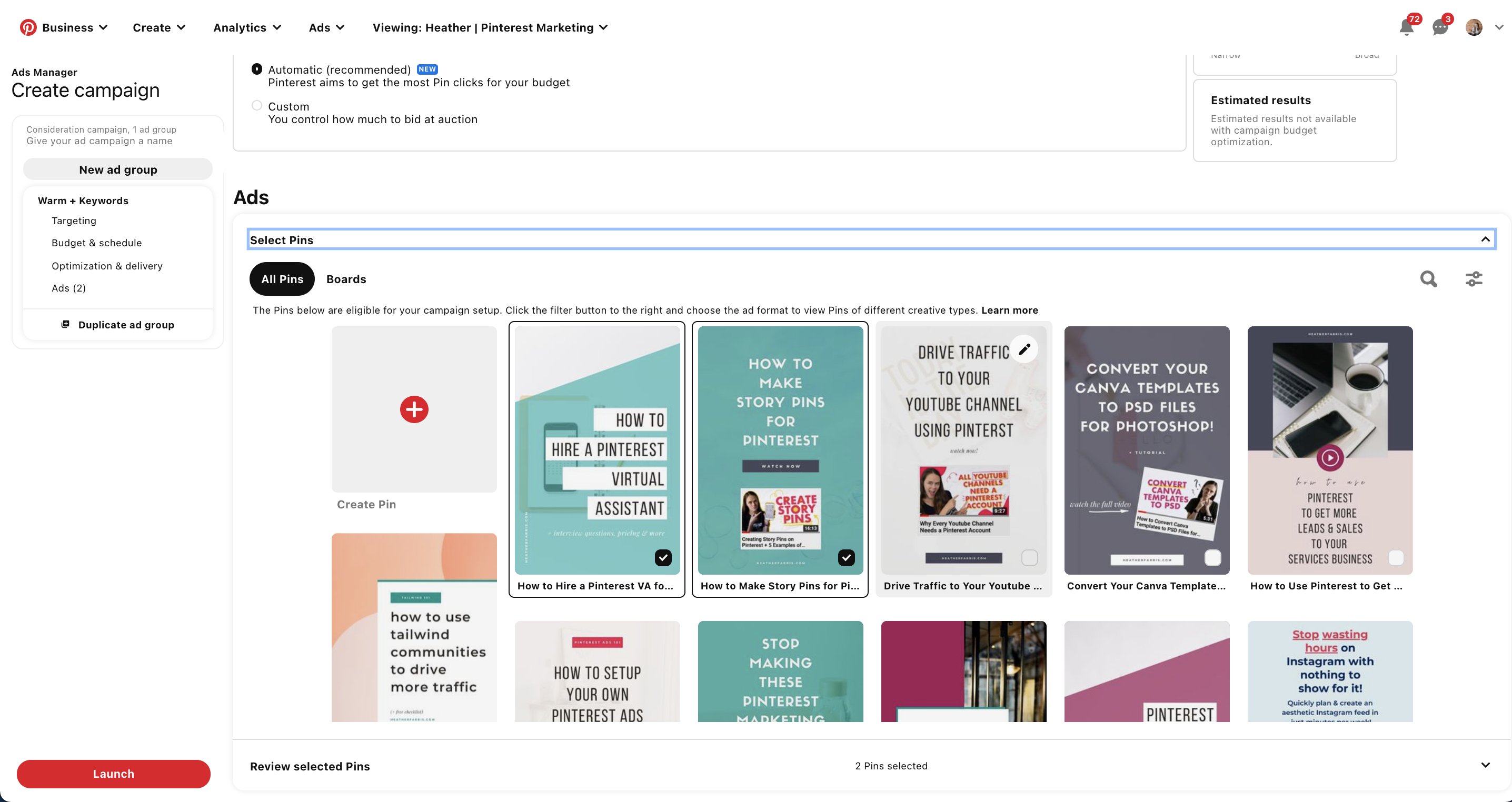
Launch
You can name your ad if you would like to have it named and then press the launch button.
Now let us get into my campaign and how it performed.
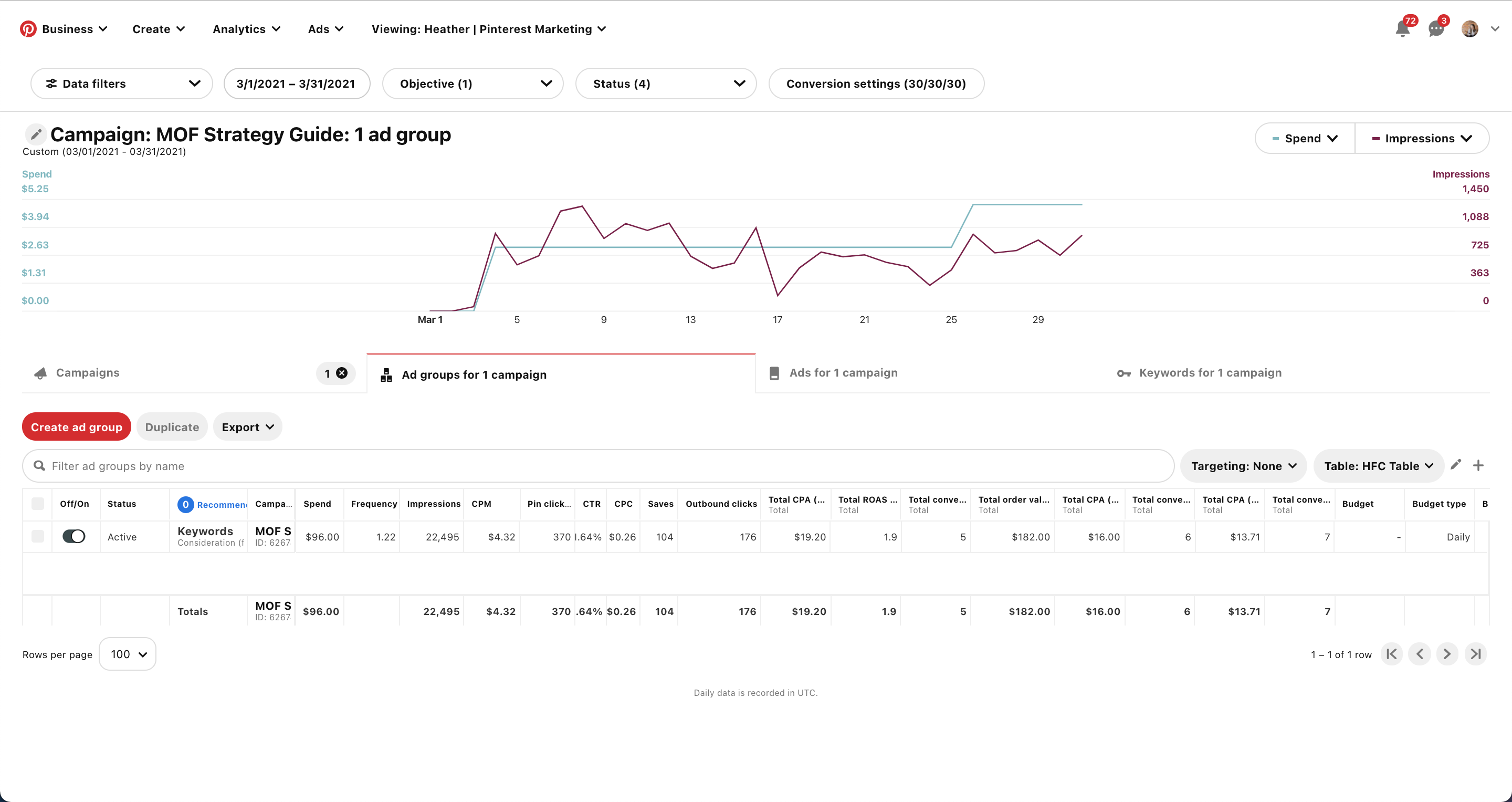
I ran this campaign from March 1 to March 31. My budget per day was $5 on automatic biddings, and I was running my leads to a page for sign-ups. I wanted to grow my email list. It died right off around March 17. This is around the time that I switched my pages to Elementor. I wasn’t tracking the leads correctly and you can see that reflected in the stats on the dashboard above. So I knew something was wrong. That’s when I went in and put it in Elementor and pulled them off Leadpages. Then it picked back again.
- So my daily spend limit at the end of March was $8.66. I had been incrementally increasing my ads.
- I spent $96 total
- My ad was seen on average 1.22 times
- Around 22,495 people saw my ad
- I paid $4.32 to reach this audience which is a bit expensive
- I had 370 pin clicks
- My click-through rate was 1.64%, which was really good
- I paid 26 cents per click
- 104 saves
- 176 outbound clicks, which means 176 people landed on my signup page
- I had five checkouts at 1.9 x ROAS, giving me $182 in sales
Overall, I am pretty pleased with my results. I run this campaign consistently and when it starts to fatigue I will pause it and swap out imagery and optimize keywords again.
Once I got my event codes to fire I was paying about $1.60 per lead at the lowest cost.
Final notes
If you want to know more about running Pinterest search ads and optimizing them grab our Pinterest Ads Checklist. You can also join Pin Profit Academy & take our beginners ads course to jumpstart your own ads.
Pin It For Later
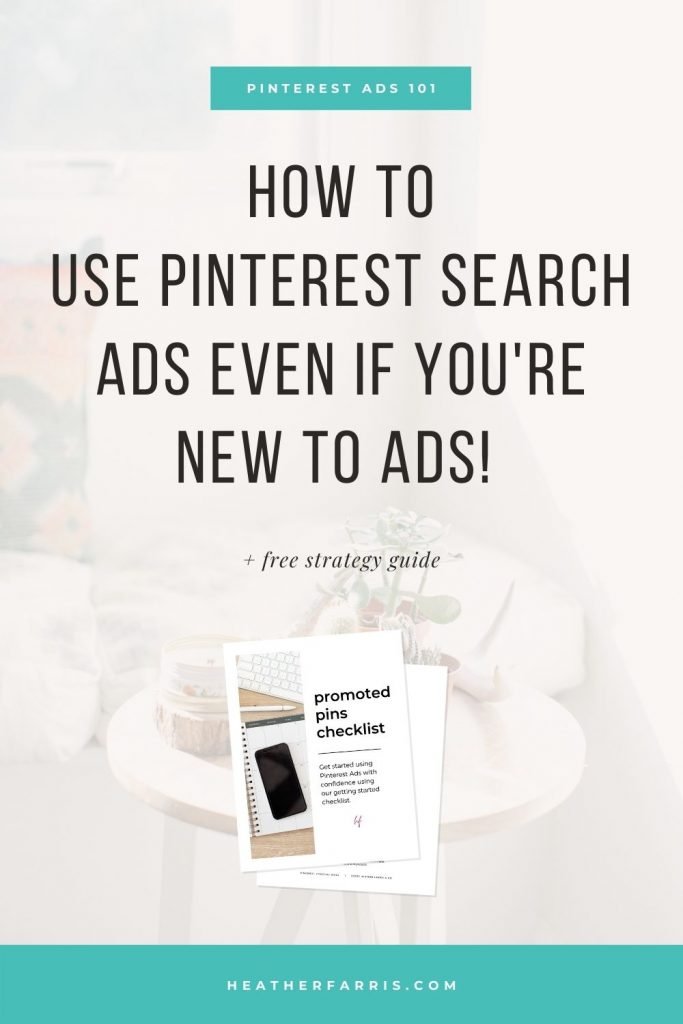
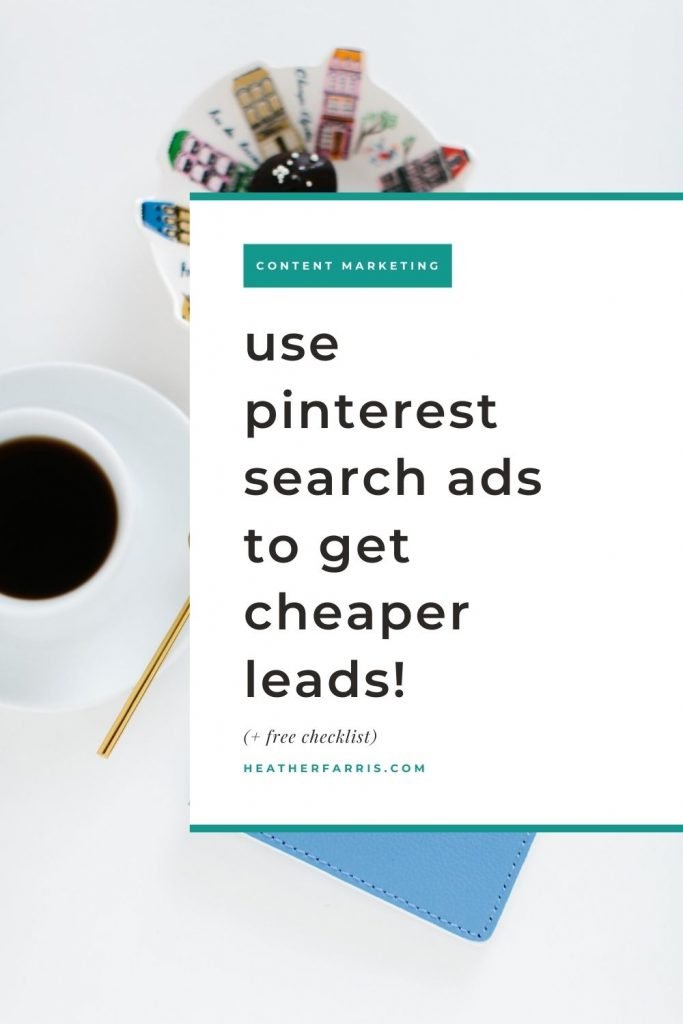
Heather Farris went to school for accounting and worked for years in banking and finance. After finding all of that entirely too boring she started her first blog in her basement in August of 2016. She has started 3 blogs in the marketing, motherhood and travel niches and used Pinterest to grow them all. She quickly became the go-to Pinterest strategist in her peer circles and has been implementing strategies, driving traffic and sales through organic and paid tactics for her clients. On this blog and her YouTube channel, as a renowned Pinterest marketing expert, she educates the public about clear and transparent marketing strategies to help them to grow on Pinterest and in other places online as a renowned Pinterest marketing expert.

